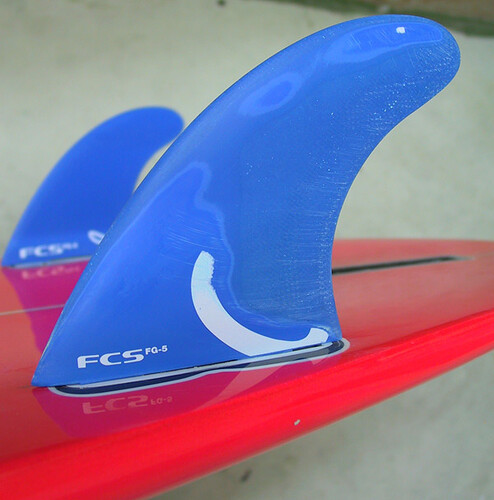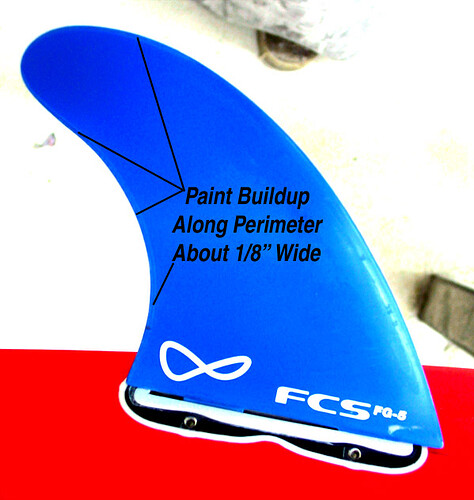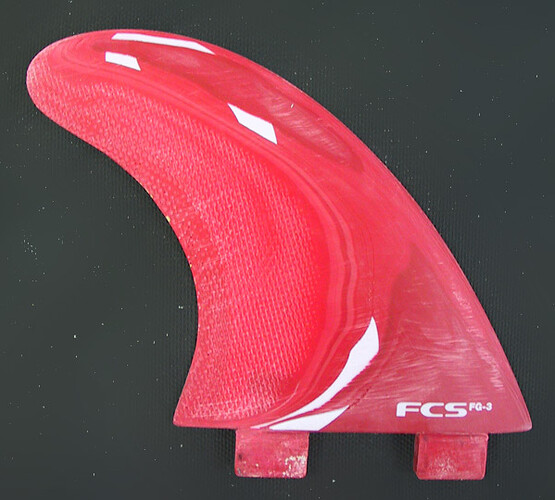Hey BB,
[=Black]With my comment, I think that the foil plays a part, but obviously isn’t the whole shebang in terms of fin performance.
Aloha Lavz
I have no disagreement with you here. It is a package deal that needs to have all aspects in sync. A good foil but a bad template for the rider, board and wave won’t allow the foil alone to save the day.
The interesting things I want to know is:
- What did you see in those fins you didn’t like?
1. Mainly they had a big bulge in the foil 2/3rds of the way back from the leading edge. You can better see where I have removed it and blended it into the foil in this photo of the red fin below.
-
The paint that was on them for the finish coat had left a builded bead around the parimeter of the fin. Especially on the trailing edge which caused humming when riding. But it was also there a bit on the leading edegs.
-
The trailing edge was too thick and it was very full and rounded 1/4" up and leading back into the edge.
-
The tips were also too thin but I didn’t take the time to build them up. I would replace them before doing that.
I get most of my glass fins from Steve Mock at Island Find Design.808-637-5347,
- What did you change about them?
As the photo below shows I took out the buldge. The reason the glass layers are showing is because I cut down into them to remove the bump.
I also thinned and flattened the trailing edge were it was too thick and rounded.
And I removed the paint builded bead at the parimeter. You can just see a faint line in the picture below, were it was around the parimeter
If someone has these type of fins or anything with a similar finish coat they need to check and make sure there is no obstruction to the water flow releasing directly off the back edges of the fins. Even if they can’t refoil the fin they can inprove it trememdously by just removing the builded up bead that commonly forms on the edge of fins when they are finish coated. This is true of all fins unless the bead has been removed or the fin wasn’t finish coated.
A lot of the surfboard industry is based on surfer review and suggestion. Individuals with abundance of inputs from surfers and the likes develope great knowledge banks of surfcraft and construction, and can just ‘see’ its not going to work and know what will work. Trial and Error is a usefull way to do things, but ultimately a blind way, in other fields, maybe not surf related, they have cracked it and done away with trial and error.
I totally understand your dream and expectation here but it may be based on a couple of false presumptions.
-
That there aren’t people who can properly interperet their feelings and inputs and make proper conclusions regarding them.
-
That the technical instruments are better at doing the analysis above even better.
I don’t necessarily agree with either of those presumptions.
I think their are people who can understand the feelings and inputs. They are few and far between and aren’t utilized like they should be primarily because of the over reaching hype and Hollywoodizing of the industry. Often the “stars” walk on the red carpet is more important then body of work they have produced leading to an award inside the building. Because of this players focus on the marketing and wind up producing crap that won’t win an Oscar. In otherwards, these FCS fiberglass fins that have a big marketing push and therefore public acceptence, but are technically lacking and not properly up to the task of winning an Oscar. They walk the red carpet just fine. But can’t hold up to the scrutiny of experts. There are not alot of experts out there and due the Hollywoodizing of our industry they are hard to find or recognize as they will be overridden by JLo’s green dress and people will become confused and eventually not even know that such real experts exist.
And those technical instruments while they are good in many applications especially where humans can’t really feel what is going on, they aren’t as applicable on things like surfboards or fins as the human connection to those items and differences between them can be felt with more accuracy then the instruments can.
Still though, those instruments in the hands of the experts might produce some interesting data that might help technically confirm some of the more subjective feelings and give us a better understanding of why we feel what we feel.
I think you may be mistaken about other industries where you think they have “done away” with Trial and Error. The use of machines and technical instruments, while they can bring some things to a much higher level of precision, have a down side that isn’t often spoken about. They are often also used by less talented people to achieve what they otherwise could not. In other words the guy with the degree hanging on the wall and the machine at his disposal is presumed to be more enlightend, capable and profecient at his job then the guy without all those who is a tinkerer in a shoddy shed somewhere. It is easy for industries and the public to embrace one and overlook the other, to everyone’s misfortune. As the genuises among us are often social misfits or iconoclasts in one form or another that don’t fit the acceptable mold. Think of guys like Howard Head, Burt Ruttan, Steve Wozniak, Paul McCready, for example. The list can go on forever. The real trick is in getting these technical tools into the hands of these guys so that great things can be done. Sadly, where the tools reside is often a big social leap away from where the Genius’s reside. Often in the end the tool like in surfboard shaping, is used to just mass produce product, rather than advance it. In the end the tool that should bring advancement actually retards development and effectively eliminates serrendippidy.
Logically, there must be properties and mathematical models behind all this to create certain features. The difficulty is its all nice and good to approximate and do simulations and theorise this and that but there is a missing link when all these computer generated designs and so on aren’t leading to amazing results. Personally I think it lies in the wave dynamics.
How the hell do you know whats going on with the fluid when its in a wave shape and the whole system is so dynamic?
Yes, that is a difficult proposition.
For me, it highlights the inherent magical quality of surfing. There is just that unknown, the mysterious factor involved with waves and surfing that is so awe inspiring.
I agree, this is part of that pixi dust that I often speak of. It is a big part of what keeps surfing so attractive to so many. And that mystery is primarily why Swaylocks exists and so many find it interesting here.
I can only sit back and look at modern surfcraft in total amazement. Look at what has been developed, from the early days of pretty much using a tree!
Surfing will never cease to amaze me.
A hui hou, (thats the closest to being hawaiian i can be) 
Ha!
L
![]()
![]()


